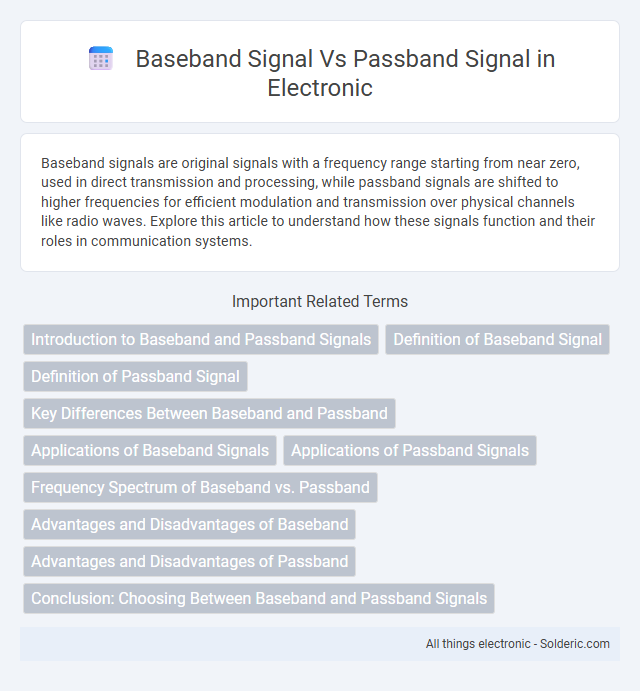Baseband signals are original signals with a frequency range starting from near zero, used in direct transmission and processing, while passband signals are shifted to higher frequencies for efficient modulation and transmission over physical channels like radio waves. Explore this article to understand how these signals function and their roles in communication systems.
Comparison Table
| Feature | Baseband Signal | Passband Signal |
|---|---|---|
| Definition | Signal with frequency spectrum starting from zero up to a maximum frequency. | Signal modulated to occupy a specific frequency band above zero frequency. |
| Frequency Range | 0 Hz to maximum baseband frequency. | Centered around a carrier frequency, with bandwidth typically less than the carrier frequency. |
| Typical Use | Direct transmission of data signals, e.g., Ethernet, digital communication within circuits. | Wireless transmission, radio, TV broadcasting, and modulated communication systems. |
| Modulation | No modulation or minimal modulation. | Requires modulation (AM, FM, PM) to shift spectrum. |
| Signal Bandwidth | Equal to data signal bandwidth. | Equal to baseband bandwidth but shifted to passband frequencies. |
| Transmission Distance | Short distance; limited due to noise and attenuation. | Long distance; enhanced by carrier frequency propagation characteristics. |
| Implementation | Simple, cost-effective transmission. | Complex, requires mixers, oscillators, and demodulators. |
| Examples | Digital data over LAN, wired Ethernet cables. | AM/FM radio, cellular communication, TV broadcasting. |
Introduction to Baseband and Passband Signals
Baseband signals occupy the frequency spectrum starting from near zero up to a certain maximum frequency, carrying original information without modulation. Passband signals result from modulating baseband signals onto a higher frequency carrier, enabling transmission over communication channels like radio waves. Understanding the differences between baseband and passband signals is crucial for designing efficient communication systems and signal processing techniques.
Definition of Baseband Signal
A baseband signal refers to a signal whose frequency spectrum is centered around zero Hz, typically representing the original, unmodulated data or information. This signal occupies a frequency range starting from near zero up to a maximum frequency, making it suitable for direct processing or transmission over short distances. Your communication system often uses baseband signals before any modulation to convert them into passband signals for long-distance transmission.
Definition of Passband Signal
A passband signal is a modulated signal shifted to a higher frequency range for efficient transmission through a communication channel. Unlike baseband signals, which occupy frequencies near zero hertz, passband signals are centered around a carrier frequency, enabling radio frequency (RF) transmission over wired or wireless media. This frequency translation helps reduce interference and allows multiple signals to coexist in the spectrum through frequency division multiplexing.
Key Differences Between Baseband and Passband
Baseband signals occupy the original frequency range starting from near zero up to a maximum frequency, making them ideal for wired communication and short-distance transmissions. Passband signals are modulated versions of baseband signals shifted to higher frequency ranges for wireless transmission and efficient bandwidth utilization. The primary difference lies in their frequency spectrum location and application, with baseband signals directly representing the data and passband signals enabling transmission over various media by adapting to channel characteristics.
Applications of Baseband Signals
Baseband signals are primarily used in digital communication systems, such as Ethernet and USB, where data is transmitted without modulation over short distances. They enable efficient processing in wired networks and local area networks (LANs) due to their low-frequency range and straightforward signal processing requirements. In contrast, baseband signaling is essential in radar, telemetry, and audio signal processing before modulation onto passband frequencies for long-distance transmission.
Applications of Passband Signals
Passband signals are essential in wireless communication systems, where they enable the transmission of data over radio frequency channels such as AM, FM, and cellular networks. These signals facilitate efficient spectrum utilization and long-distance transmission by modulating baseband signals onto higher frequency carriers. Common applications include satellite communications, TV broadcasting, and Wi-Fi, where passband signaling ensures robust data transfer over varying channel conditions.
Frequency Spectrum of Baseband vs. Passband
The frequency spectrum of a baseband signal is centered around zero Hertz, covering low-frequency components from near DC up to a certain cutoff frequency. In contrast, a passband signal's spectrum is shifted to a higher frequency range, typically occupying a band around a carrier frequency well above zero Hertz. This spectral translation enables efficient transmission over communication channels by modulating the baseband data onto a suitable carrier frequency.
Advantages and Disadvantages of Baseband
Baseband signals, which transmit data at their original frequency without modulation, offer the advantage of simplicity and reduced hardware requirements, making them ideal for short-distance communication and digital transmission systems like Ethernet. However, baseband signals are susceptible to noise and signal degradation over long distances and are limited in coexistence with multiple channels due to bandwidth constraints. Understanding the limitations of baseband can help you choose the right signaling method for efficient data transmission in your network.
Advantages and Disadvantages of Passband
Passband signals enable efficient transmission over wireless channels by shifting baseband signals to higher frequencies, reducing antenna size and improving signal reach. However, passband modulation introduces complexity in transmitter and receiver design, as well as potential issues like bandwidth expansion and susceptibility to noise and interference. Understanding these trade-offs helps you optimize communication system performance according to bandwidth availability and channel characteristics.
Conclusion: Choosing Between Baseband and Passband Signals
Choosing between baseband and passband signals depends on the application's frequency requirements and transmission medium. Baseband signals are ideal for short-distance communication and digital data transmission due to their low-frequency spectrum and simplicity. Passband signals, utilizing frequency modulation and higher-frequency carriers, are preferred for long-distance wireless transmission and multiplexing over shared channels.
baseband signal vs passband signal Infographic

 solderic.com
solderic.com